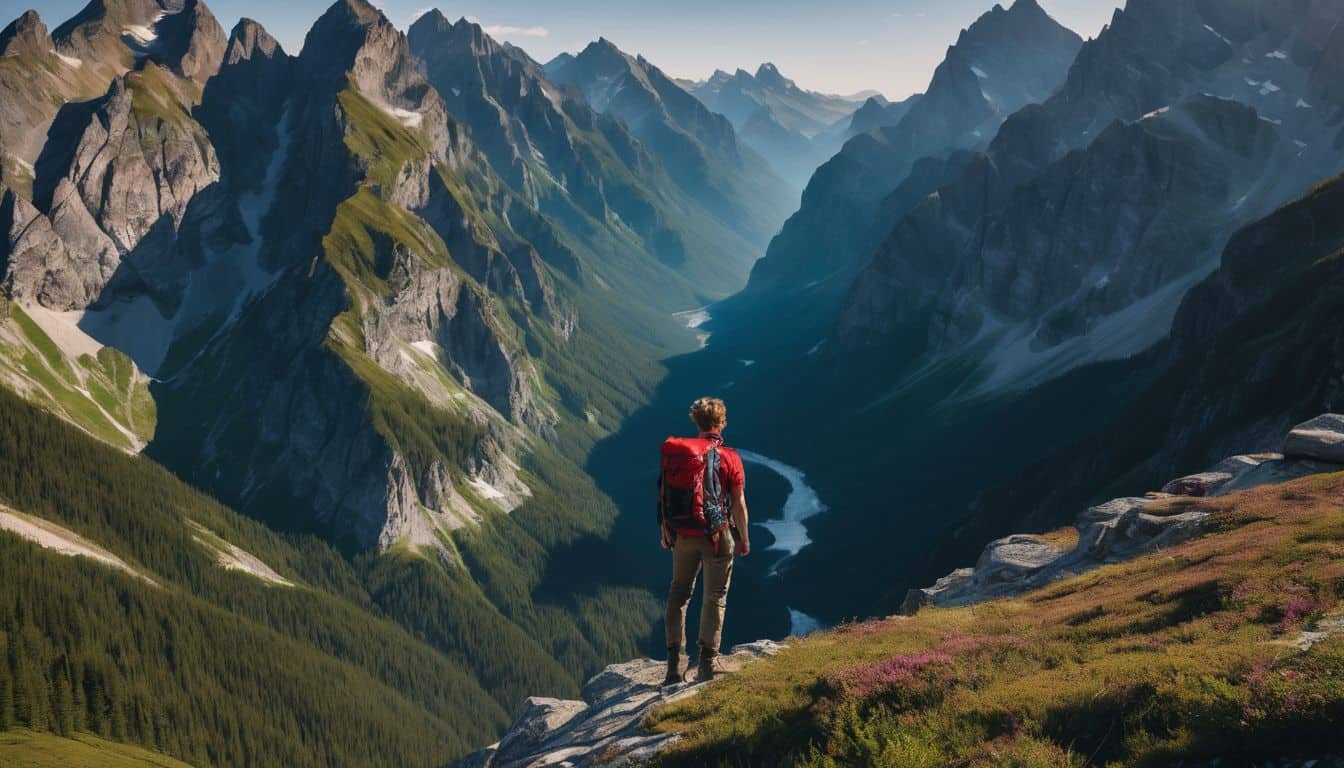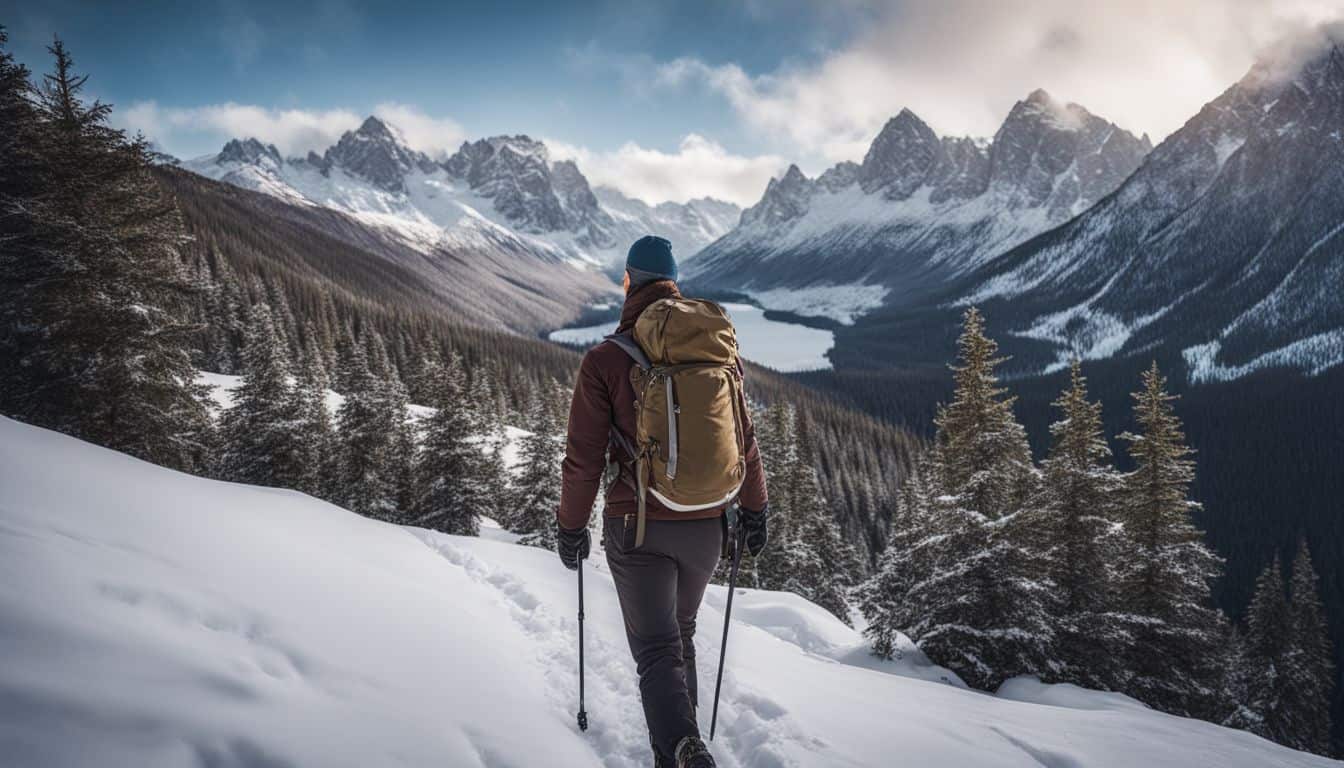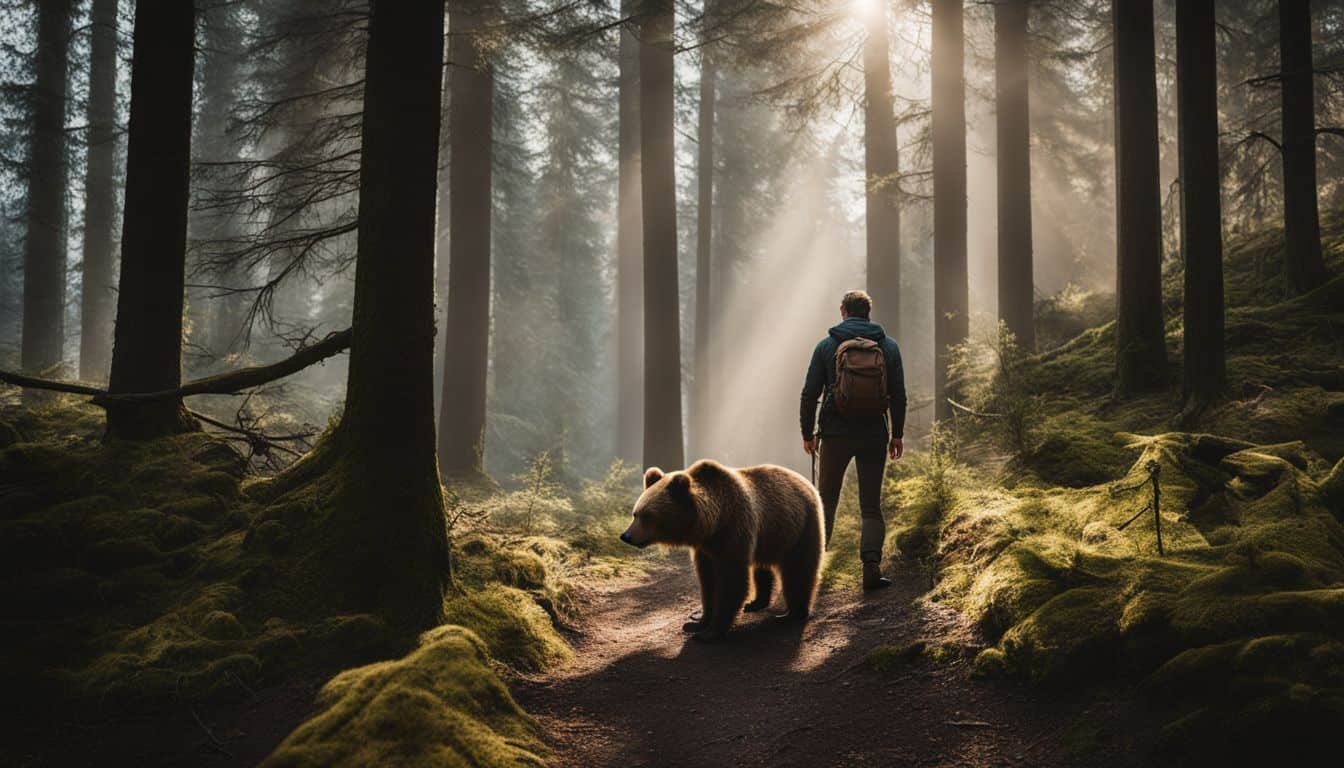So you fancy yourself an outdoor aficionado, confident in your mastery of wilderness survival skills? Trust me, I also basked in that self-assurance until the day I stumbled upon a myriad of survival myths which could endanger lives instead of protecting them.
This comprehensive article will lift the veil on these common yet perilous misconceptions and arm you with real, reliable tactics to conquer nature’s tests. Ready to embark on a myth-busting adventure? Strap in folks, let’s get this journey started!
Key Takeaways
- Rubbing frostbitten skin is not effective and can cause more damage.
- Drinking alcohol does not warm you up in cold weather, it actually makes you lose heat faster.
- Cotton clothing is not suitable for staying warm in the cold, choose wool or man-made fabrics instead.
- Feeding a hypothermic person is not recommended; focus on warming them up and seeking medical attention.
- Letting a hypothermic person sleep is dangerous, keep them awake while warming them up.
- Sitting in a hot tub will not cure hypothermia, seek immediate medical assistance instead.
- Eating raw meat and seafood can be unsafe and increase the risk of foodborne illnesses.
Debunking Cold Weather Survival Myths
Rubbing frostbitten skin is not an effective way to warm up and can actually cause more damage.
Rubbing frostbitten skin
You may think that rubbing frostbitten skin is a good idea. It’s not. Doing so can hurt your skin more, not less. Frostbite means your skin got too cold and suffered damage. If you rub it, the tender tissue might come off completely.
This does not help to warm up that area or fix the cold damage at all. Instead, it may lead to even more harm for those tissues already in pain from the frostbite.
Drinking liquor to warm up
Drinking liquor to warm up in cold weather is not a good plan. While it may make you feel warmer, it can cause more harm than good. The Army Research Institute did a study about this.
They found that alcohol makes your blood vessels open up more at the skin level. This means heat from your core can move out into the cold air faster.
You might think you’re staving off frostbite and hypothermia by drinking booze, but you’re not. Sure, alcohol may keep you from shivering as much in the snow or chill wind. But actually, your body loses heat even quicker when you drink! It’s better to dress warmly and stay dry if it’s freezing outside.
Believing all base layers work equally well
Not all base layers are the same. Many people think they can just throw on a cotton shirt and be okay in cold weather. This is not right! Cotton is not good for keeping warm when it gets wet from sweat or snow, it takes a long time to dry out.
That’s why you get cold if you wear cotton in bad weather, it could even lead to hypothermia! There are other types of clothes that work better than cotton, like wool and some man-made fabrics.
You must pick the right kind of clothes if you want to stay safe in the cold.
Feeding a victim of hypothermia
When treating a victim of hypothermia, it is important to remember that feeding them is not recommended. The body’s digestion process can actually divert blood away from vital organs and contribute to further cooling.
Instead, focus on warming the person by wrapping them in thermal blankets or clothing, providing warm fluids if they are conscious and able to swallow safely, and seeking immediate medical attention.
Feeding should only be done under professional supervision once the person has been properly rewarmed and stabilized.
Letting a hypothermic victim sleep
If you find someone who is hypothermic, it’s really dangerous to let them sleep. Sleeping can actually make things worse and even lead to death. So it’s important to keep the person awake as they are being warmed up.
Sleeping doesn’t help a hypothermic victim heat up faster, and it’s actually a serious warning sign that something is wrong. The main thing we need to do when someone has hypothermia is to warm them up, not let them sleep.
Relying on a hot tub to cure hypothermia
Whenever I hear about hypothermia, it reminds me of an important myth that needs debunking. Some people believe that sitting in a hot tub is the perfect solution to cure hypothermia.
However, this is far from the truth. Hot tubs may feel comforting and warm, but they are not effective in treating hypothermia.
In fact, plunging a hypothermic victim into a hot tub can actually be dangerous. The sudden exposure to extreme heat can cause their heart rhythm to become irregular or lead to other complications.
It’s important to remember that proper medical attention and treatment are necessary for someone suffering from hypothermia.
Debunking Animal Encounter Survival Myths
Eating raw meat or seafood can actually increase the risk of foodborne illnesses and should be avoided in a survival situation.
Eating raw meat and seafood
I want to debunk the myth that eating raw meat and seafood is safe for survival. Although consuming certain types of raw seafood from saltwater can be safe, overall, uncooked food can be dangerous.
Raw animal flesh contains harmful pathogens that can make you sick or even fatal. It’s important to cook meat and seafood thoroughly to kill these bacteria and ensure your safety. Additionally, relying solely on a carnivorous diet that excludes fruits, vegetables, grains, and other essential nutrients is unhealthy and unsustainable in the long term.
It’s crucial to have a balanced diet for optimal survival. Furthermore, regular consumption of processed meat increases the risk of cardiovascular diseases and cancer. So remember, when it comes to eating raw meat and seafood for survival purposes, it’s best to avoid them altogether.
Assuming you can eat anything animals eat
In survival situations, it is a common myth that you can eat anything animals eat. However, this is not true and can be dangerous. Humans and animals have different digestive systems, which means that foods that are safe for animals may be harmful or toxic to humans.
Consuming the same food as animals can lead to severe consequences such as poisoning and digestive issues. Therefore, it is important to debunk this myth and focus instead on identifying safe and edible plant-based food sources.
It’s also essential to learn proper hunting and gathering techniques in order to ensure your survival without putting yourself at risk of harm or illness.
Cutting and sucking a snakebite
When it comes to snakebites, there is a common myth that says you should cut the wound and suck out the venom. However, this technique is not recommended and can actually make things worse.
Cutting the bite area can cause more damage and increase bleeding, while sucking on the wound can introduce bacteria into the bloodstream.
Instead of cutting and sucking a snakebite, it’s important to focus on other first aid measures. The best thing you can do after a snakebite is to seek immediate medical help. Call emergency services or get to a hospital as soon as possible.
They will have the proper equipment and knowledge to treat the bite effectively.
Debunking Navigation Survival Myths
Believing moss always grows on the north side of trees. Learn the truth about how to navigate in the wild and avoid getting lost. Read on to discover more debunked navigation survival myths.
Believing moss always grows on the north side of trees
I used to believe that moss always grows on the north side of trees, and I’m sure many others do too. But here’s the truth: that belief is just a myth. Moss doesn’t exclusively grow on the north side of trees at all.
In fact, moss grows wherever it can survive best, not based on any particular direction. It prefers damp conditions and can actually grow in any direction, including south-facing spots.
So if you ever find yourself in a survival situation and you’re relying on moss to navigate, think again! It’s an unreliable method and should not be depended upon for finding your way.
Thinking a GPS will prevent getting lost
I used to believe that having a GPS meant I would never get lost. But I’ve learned that this is just a myth. While GPS devices can be helpful for navigation, they don’t guarantee that you won’t find yourself off track.
There are several reasons why relying solely on a GPS can lead to trouble. For one, technology isn’t perfect and GPS signals can sometimes be unreliable or disrupted. This means that your device may not always be able to accurately pinpoint your location.
Another important factor to consider is that depending too much on a GPS can actually weaken our navigational skills over time. When we rely solely on the voice prompts and directions from the device, we stop using our own natural sense of direction and spatial awareness.
This reliance on technology hampers our ability to navigate effectively without it.
Following flying birds to find water
Following flying birds to find water is a survival myth that has been debunked. While it may seem logical to think that birds can lead us to water, it’s not always the case. Some aquatic birds rarely leave the water’s edge, while others roam far and wide for food.
The direction in which birds fly does not always indicate the location of water sources. So, relying on bird flight alone is not a reliable method for finding water in survival situations.
It’s important to consider other strategies and resources when it comes to locating this essential resource.
An Overview of Common Survival Myths Debunked
[Draft Content]
As a fellow survival enthusiast, it’s absolutely crucial for us to separate fact from fiction when it comes to common survival myths. So let’s dive in and debunk some of the most widespread misconceptions, giving you accurate information for your thrilling outdoor adventures.
Now, picture this: you’re out exploring nature, and suddenly you come face-to-face with a snake! There’s a myth that says sucking out the venom can save someone from a snakebite. But trust me on this one, my friend – that is not only dangerous but also ineffective.
If you or someone else gets bitten by a snake, don’t hesitate for even a moment – seek medical assistance right away.
Here’s another myth that might have caught your attention: playing dead in dangerous situations. Now listen up; while there may be rare cases where this tactic works, it’s absolutely vital to assess the situation carefully before deciding on an appropriate action.
Sometimes fighting back or making a swift getaway might just be the smarter choice.
Ah yes, the everlasting quest for water sources.. We’ve all been there before. But let me tell you something important: never assume that all those seemingly pristine streams are safe to drink straight from the source.
Even if they’re crystal clear and flowing beautifully like mother nature intended – waterborne illnesses could still lurk within them! So always remember to purify any water before taking that much-needed sip.
Alright now, my fellow adventure seeker – these were just a few examples of those pesky survival myths floating around among us outdoor enthusiasts. By separating fact from fiction and staying informed about proven survival techniques, we’ll be ready as ever to tackle whatever challenges await us during our wilderness escapades!
Debunking Shelter Survival Myths
Building a fire in a cave for warmth is not always the best option due to poor ventilation and potential dangers.
Building a fire in a cave for warmth
I used to believe that building a fire in a cave was the best way to stay warm during survival situations. But now, I know that it’s actually a myth associated with shelter survival.
You see, heat causes rock to expand, and when this happens inside a cave, it can lead to dangerous consequences like rocks breaking or even collapsing. Cavemen may not have known any better, but we now understand the risks involved in creating fires inside caves.
So instead of relying on this outdated method, there are safer options for heating in caves that we should explore.
Preferring a big fire over a shelter
In survival situations, some people believe that having a big fire is more important than building a shelter. They think that the warmth from the fire will be enough to keep them safe and comfortable.
However, this belief can be dangerous and should not be followed blindly. While a fire can provide heat, it does not offer the same level of protection as a well-built shelter. A shelter helps to keep you dry and protected from wind and other elements, which are crucial for staying warm in cold weather conditions.
It also gives you a sense of security and privacy. Building a fire may seem easier, but neglecting to build a proper shelter can put your safety at risk. So remember, while having a fire is important for warmth, don’t underestimate the importance of building a sturdy shelter as well.
Dismissing the usefulness of space blankets
Space blankets are often seen as a go-to solution for staying warm in survival situations, but it’s important to question their effectiveness. While they do provide some insulation and help retain heat, there are concerns about their durability and thickness compared to other survival blankets and bivvies.
They may not be the most reliable option for protecting against extreme weather conditions. It’s essential to explore other proven methods and equipment for shelter and cold protection rather than relying solely on space blankets.
Don’t just assume that these thermal blankets are the ultimate solution – seek information from trusted sources and consider alternative options that are more weatherproof and durable.
Believing lean-tos make great shelters
When it comes to building a shelter for survival, there is a common myth that lean-tos make great shelters. However, this is not always the case. The perfect shelter depends on the surrounding conditions and environment.
Factors such as high heat requiring shade or cooler temperatures requiring different shelter options need to be taken into consideration. It’s important to think about specific conditions when choosing what kind of shelter to build in order to ensure your safety and comfort in a survival situation.
Debunking Fire Starting Survival Myths
In this section, we will debunk common fire starting survival myths and provide alternative strategies for starting a fire in emergency situations.
Rubbing two sticks together to make a fire
To start a fire using only sticks, you can rub them together to create friction. This friction generates heat that can lead to a smoldering charcoal. It’s important to note that not all types of wood are suitable for creating a fire through this method.
You need to choose the right combination of woods, such as softwood and hardwood, to achieve success. Additionally, mastering the technique of rubbing two sticks together takes practice and skill.
It’s one of the basic survival skills for starting a fire with minimal resources. So remember, while it is possible to create a flame by rubbing two sticks together, it requires specific wood types and proper technique.
Using a thumbnail to test wood
I used to believe that using my thumbnail to test wood for fire starting was a reliable method. But I’ve learned that this is actually a myth. The hardness of the wood plays an important role in its ability to ignite, and the “thumbnail test” is not a reliable way to determine this.
Other factors like moisture content and resin content also contribute to how suitable the wood is for fire starting. It’s important to remember that relying on incorrect fire starting methods can put our lives at risk.
So instead, let’s focus on using proven techniques and materials for building fires in survival situations.
Thinking nose grease is the perfect fire starter
I used to believe that nose grease was the ideal fire starter when I first started learning survival skills. However, after doing some research and experimenting, I have come to realize that this is just a myth.
Nose grease does contain some oil, but it is not enough to effectively lubricate a bow-drill spindle or ignite a fire. When it comes to starting a fire in the wild, there are much better options available.
Water procurement, shelter building, and maintaining a good fire are all more important for survival than relying on nose grease as a fire starter. So if you find yourself in a survival situation, remember to focus on these essential elements rather than wasting time trying to start a fire with nose grease alone.
Assuming hardwood is best for friction fires
When it comes to friction fire starting, many people assume that hardwood is the best choice for success. However, in my experience as a survival enthusiast, I have found that choosing the right wood is more important than simply relying on hardwood.
While hardwood can indeed be a good option, other woods like mullein and cedar can also work well. The key is to experiment with different types of wood and see what works best for you in your specific region.
Don’t limit yourself to just one type of wood – explore alternative options and find what works for you.
Thinking wet matches will work when dried
Wet matches won’t work when you try to dry them out. This is because the chemicals in match heads can easily get damaged by moisture. When matches get wet, the chemicals become less effective and may not ignite properly.
So even if you let them dry, they might not light up when you need them the most. It’s important to keep your matches protected from water to ensure they will work when you really need them for starting a fire in a survival situation.
Believing in the effectiveness of an eight-sided bow drill
Using an eight-sided bow drill to start a fire is not as effective as some might believe. Contrary to popular belief, it is difficult and requires practice. Factual evidence does not support the idea that an eight-sided bow drill is a reliable method for starting a fire.
However, there are other fire starting techniques that can be more successful, such as using flint and steel or creating sparks with a ferrocerium rod. It’s important to consider alternative methods when building your survival skills repertoire.
Debunking Hydration Survival Myths
Drinking your own pee to stay hydrated, drinking raw blood for survival, sucking on a stone for hydration, and eating snow for water are all debunked myths when it comes to staying hydrated in survival situations.
Drinking your own pee to stay hydrated
Drinking your own pee to stay hydrated is a survival myth that needs to be debunked. Experts strongly advise against relying on urine as a method of hydration in a life or death situation.
It is important to understand that drinking urine does not provide reliable hydration and can actually be harmful to your body. The belief that it can help with hydration is a misconception.
In reality, the only way to extract water from urine in a survival situation is by evaporating it and condensing the vapor. Therefore, it is crucial to explore alternative methods of hydration rather than resorting to drinking urine.
Drinking raw blood for survival
Drinking raw blood as a survival method to stay hydrated is a myth that needs debunking. While it’s true that blood contains water, consuming it directly can be dangerous and unhealthy.
Animal blood may contain harmful bacteria or parasites that could make you sick instead of helping you rehydrate. It’s important to remember that there are safer and more effective ways to stay hydrated in survival situations.
Drinking clean water, finding edible plants with high water content, or even collecting dew from leaves are all better options for replenishing fluids in your body. So, don’t rely on drinking raw blood for survival – stick to proven methods of hydration instead.
Sucking on a stone for hydration
I used to believe that sucking on a stone could help quench my thirst in survival situations, but it turns out that this is just a myth. Sucking on a stone does not provide any water or hydration.
Even though saliva may form in your mouth, it doesn’t actually quench your thirst or keep you hydrated. It’s important to understand that this method has been debunked and isn’t an effective way to stay hydrated.
If you find yourself dehydrated, the best course of action is to drink clean water. Make sure to filter or purify the water if necessary and avoid drinking untreated running water, even if it looks clean.
Eating snow for water
I used to believe that eating snow was a good way to stay hydrated when I found myself in a winter survival situation. But it turns out, this is actually a dangerous myth. Eating snow can lower your body temperature and make you even more dehydrated.
In fact, it takes energy for your body to melt the snow, which could lead to further dehydration. So, if you find yourself stranded outdoors during winter and need water, it’s best to find another source rather than relying on eating snow.
It’s important to be aware of the cold weather dangers and take steps to prevent frostbite and manage your thirst effectively. And remember, this advice applies not only to humans but also our furry friends – eating snow can dehydrate dogs too! Stay safe and always prioritize finding safe water sources in outdoor emergencies.
Conclusion on Survival myths debunked
In conclusion, debunking common survival myths is essential for anyone who wants to be prepared in the great outdoors. By challenging assumptions and educating ourselves with accurate information, we can increase our chances of survival in challenging situations.
Remember to fact-check survival tips and be willing to adapt your strategies based on reality rather than misconceptions. Stay safe out there!
Additional Survival Tips
Here are some extra tips to help you survive in the wilderness:
- Stay calm and think clearly.
- Always carry a survival kit with essential items.
- Know how to find and purify water sources.
- Learn basic first aid skills.
- Build a shelter to protect yourself from the elements.
- Know how to start a fire using different methods.
- Learn navigation techniques like using a compass or natural landmarks.
- Be aware of your surroundings and avoid potential dangers.
- Pack enough food for emergencies, such as energy bars or dried fruits.
- Stay positive and keep a strong will to survive.
Resources and References.
In my quest to debunk survival myths, I have gathered a wealth of resources and references that can help you separate fact from fiction. These sources provide reliable information and expert advice on various topics related to survival.
When it comes to debunking common misconceptions and urban legends, it’s crucial to rely on accurate facts and trustworthy sources. By accessing these resources, you can gain valuable insights into proven techniques for survival and learn the truth behind popular myths.
Whether you’re interested in cold weather survival, animal encounters, navigation skills, shelter building, fire starting, or hydration tips, these resources will equip you with the knowledge you need to thrive in challenging situations.
So let’s delve into the world of reliable information and discover the truth together!
FAQs on Survival myths debunked
1. What are some common survival myths that have been debunked?
Some common survival myths that have been debunked include the idea that sucking venom out of a snakebite is effective, moss only grows on the north side of trees, and drinking urine can hydrate you in an emergency.
2. How can I win in a survival situation?
You can increase your chances of winning in a survival situation by staying calm, assessing your resources, finding shelter and water, building a fire for warmth and signaling for help, and using your knowledge and skills to navigate or find food.
3. Can anyone survive in extreme conditions with these 7 ways mentioned?
While the 7 ways mentioned provide valuable tips for surviving in various situations, it’s important to note that individual factors such as health condition, physical fitness, and prior experience may also play a role in determining one’s ability to survive.
4. Is it true that running water is always safe to drink from outdoors?
No, running water is not always safe to drink from outdoors as it could still contain harmful bacteria or parasites. It’s best to purify any water source by boiling it or using water purification tablets before consuming.
5. Are there any other strategies not covered in this guide that could help me survive?
Yes, there are many other strategies beyond the ones covered in this guide that could help you survive. It’s important to continue educating yourself about survival techniques through reputable sources and training programs.






Leave a Reply